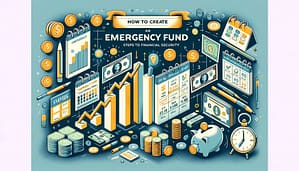In today’s uncertain economic climate, having an emergency fund is more than just a financial safety net—it’s a critical component of financial security. An emergency fund can help you navigate through unexpected events such as job loss, medical emergencies, or urgent home repairs without derailing your finances. Here’s a step-by-step guide to starting and maintaining an emergency fund.
Understanding the Importance of an Emergency Fund
An emergency fund is essentially a buffer that protects you from the unpredictability of life. Without it, any unexpected expense could force you into debt, potentially setting back your financial goals significantly. The peace of mind that comes with knowing you have a financial cushion cannot be overstated.
Step 1: Set Your Savings Goal
The first step in creating an emergency fund is to determine how much you need to save. While the traditional advice is to save three to six months’ worth of living expenses, your individual situation might require more or less. Consider factors like job stability, health, and whether you have dependents.
Table: Suggested Emergency Fund Size
| Situation | Suggested Size of Emergency Fund |
| Single income, stable job | 3-6 months of expenses |
| Freelancer or variable income | 6-12 months of expenses |
| Single parent or sole breadwinner | 6-9 months of expenses |
| Dual income, no children | 3-6 months of expenses |
Step 2: Choose the Right Account
Your emergency fund should be easily accessible, but not so accessible that you’re tempted to dip into it for non-emergencies. A high-yield savings account is often the best option, offering better interest rates than a standard checking or savings account without sacrificing accessibility.
Step 3: Start Saving
If saving several months’ worth of expenses seems daunting, start small. Even saving a small amount from each paycheck can build up over time. Automate your savings if possible, setting up a direct transfer from your checking account to your emergency fund after each payday.
Step 4: Build Your Fund Gradually
Focus on building your emergency fund gradually but consistently. If you receive a tax refund, bonus, or any other unexpected windfall, consider allocating a portion of it to your emergency fund.
Step 5: Maintain Your Fund
Once you’ve reached your emergency fund goal, don’t stop there. Regularly review your fund to ensure it aligns with your current living expenses, especially if your financial situation changes. If you need to use your emergency fund, prioritize replenishing it as soon as possible.

Tips for Growing Your Emergency Fund
- Cut Unnecessary Expenses: Review your budget for areas to cut back, such as dining out, subscriptions you no longer use, or luxury services.
- Increase Your Income: Consider taking on freelance work, a part-time job, or selling items you no longer need.
- Save Windfalls: Allocate a portion of any windfalls, such as tax returns or bonuses, directly to your emergency fund.
Overcoming Common Challenges
Starting from Zero
If the idea of saving several months’ worth of expenses feels overwhelming, remember that the journey of a thousand miles begins with a single step. Start by setting a small, achievable goal—such as saving $500—and gradually increase your target as you become more comfortable with the habit of saving.
Staying Motivated
Keep your motivation high by celebrating milestones, no matter how small. Tracking your progress visually, such as with a chart or spreadsheet, can also help you stay on track.
Handling Setbacks
Life is unpredictable, and there may be times when you need to dip into your emergency fund. If this happens, don’t be discouraged. The fund served its purpose by keeping you afloat during a difficult time. Focus on rebuilding it once you’re able, and adjust your savings strategy if needed to prevent future setbacks.
Conclusion
Creating and maintaining an emergency fund is one of the most important steps you can take towards financial stability and peace of mind. By setting clear goals, choosing the right savings account, and saving consistently, you can build a financial buffer that protects you against life’s unexpected challenges. Remember, the best time to start is now—your future self will thank you.
